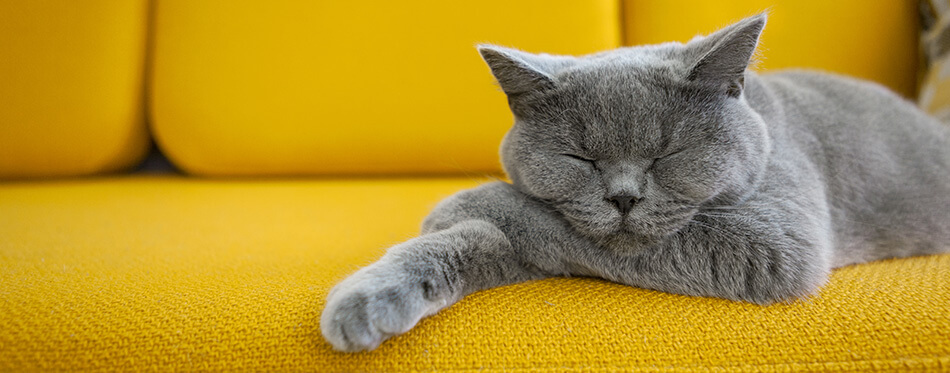Cat senses are amazing! If you don’t believe me, then let’s explore the stunning world of cat senses together. A cat, like most animals, has five senses: Smell, taste, touch, sight and hearing. Felines need all of these to gain information about their environment, protect them from predators, and hunt their own prey. Even humans have this same basic anatomy – ears, eyes, nose, tongue – with touch receptors on the skin. However, there are some significant differences. A cat can swivel their ears towards the location of a noise. They also have whiskers! But above all, cats’ senses are stronger, more adept, and can heighten their behavior.
Interested? Read on to find out more about your cat’s intricate, outstanding senses, and how they help keep your cat happy and healthy.
What are a Cat’s Strongest Senses?
A cat’s acute senses give them accurate information about their environment, help them avoid potential predators, and allow them to seek out prey. In the wild, animals simply cannot survive without this ability.
However, a cat’s sense of smell is their strongest sense. How strong is a cat’s sense of smell, you ask? Well, it is at least 14 times more powerful than a human’s. This explains how cats are able to identify people and objects in their environment. Humans have just 5 million odor sensors in their noses, while cats have over 200 million!
This makes cats very sensitive to a range of smells within the home – including scented cat litter. Keep in mind: They don’t like the smell of citrus fruits or bananas!
Your cat will immediately know if another animal (or a new human) has been in your house. They will spend ages sniffing furniture and other items like shoes and coats just to figure out more about this mysterious visitor. If you have a box delivered, it is sure to be checked out first by your cat!

Cat Sense of Smell
So, how do cats smell so acutely and how can you help keep from overwhelming this great and useful sense?
A cat’s sense of smell is very intricate and is vital for bonding and mating. It is also essential for exploring the world around them and feeling comfortable in their surroundings.
Some experts believe a cat’s smell can function better than a dog’s. This is because they have two sets of scent receptors, which is unusual. Cats have the regular olfactory receptors that pick up chemicals in the air, while also possessing another layer of receptors in what is called the vomeronasal organ. This organ is located in a cat’s mouth and picks up pheromone messages left by other cats. That explains why your cat sometimes appears to be smelling with their mouth open! Pheromones are a type of hormone that cats use for social and mating activities. They are often the primary hormone used to mark their territory.
Cats can also suffer from upper respiratory viruses, often caused from excessive sneezing. Vaccinations can help to prevent this condition, but some cats become life-long carriers of the infection. However, sneezing can also be caused by dental infections, sinus infections, nasal polyps or tumors. If you have any concerns about your cat’s nasal symptoms, contact your vet.
Cat Sense of Taste
Humans taste their food using taste receptors located on their tongues. Cat’s have rough tongues that they use for grooming and removing loose hair. But the question remains: Do cats have taste buds on their tongues, too?
Yes, they do! A cat’s taste buds are located on their tongue, near the raised areas, but they only have a few hundred of them. For comparison, humans have more than 9,000 taste buds! There’s certainly a lot less that they can taste!
For example, cats don’t have a sweet tooth, as they cannot taste anything sweet. They enjoy their food with their nose, rather than their mouth, and may appreciate some textures more than others. If a cat is enjoying a sweet snack, it is because they are attracted to the fat content rather than the taste.
Cat Sense of Sight
Cats have large eyes located at the front of their face with large pupils – categorizing them as predators. This eye positioning gives them a wide field of vision, which is perfect for seeking prey. They also have excellent movement detection abilities, making them effective hunters.
When it comes to colors, their eyesight is not so great. A cat’s visual spectrum is made up of mainly greens and blues. They cannot really see reds or pinks, so you may want to stick to blue and green toys.
Cats have a blind spot situated under their chin, so they literally cannot see things that are under their nose!
A cat’s eyes are adapted for seeing in dim-lighted conditions. Because of this, they possess stronger eyesight around the time of dusk and dawn, which is typically when they hunt for food.
Cat Sense of Touch
Cat’s whiskers provide their most sensitive touch, but other parts of their body are important, too. From a very young age, cats enjoy being groomed. It lowers their heart rate and relaxes their muscles. You can encourage this by stroking their fur.
Their whiskers are highly sensitive touch organs connected directly to their nervous system. Positioned on either side of their face, they are connected to highly sensitive cells with lots of nerve endings. Cats can detect even the slightest movement!
Whiskers can catch subtle changes in the environment, too, including wind direction. When it comes to a sense of touch, whiskers are far superior to anything a human possesses. Whiskers act as a type of radar and can help a cat to navigate their way around, even when the light is poor.
Cat Sense of Hearing
Cats have an excellent sense of hearing. Their ears can detect sounds over a wider range of frequencies than dogs. In the wild, cats need to have good hearing to better detect their prey and to hear the sound of a predator sneaking up on them.
A cat’s outer ear has lots of little muscles. It can rotate around 180 degrees and face the direction of the sound. For this reason, cats are very good at pinpointing exactly where a sound is coming from.
FAQ:
Q: Do cats have a sixth sense?
A: Many people believe that their pets possess a mysterious “sixth sense”, or the ability to know what they are thinking, to predict a dangerous occurrence, or to communicate in special ways with humans. No one really knows if this is true, but there is some evidence to suggest that cats may possess special powers. Cats have transformed the lives of people living with dementia and autism by forming a deep connection with them. Also, a cat’s inner ear can detect changes in air pressure, so they can predict when the weather is about to change.
That certainly sounds like magic!
Q: Are cats’ sense of smell as good as dogs?
A: The smelling abilities of dogs and cats are often compared. Dogs can generally smell better than cats because they have more scent receptors, though some experts believe that cats can smell better because of their double receptors. For example, the Bloodhound has more than 300 million scent receptors and can smell things from miles away! But the cat can detect other cats’ hormones using their mouth.
There are dog breeds that have less receptors than cats, making a cat’s smell stronger. The sense of smell in both animals can also deteriorate with age.
Q: Can cats really see in the dark?
A: Cats do not have night vision, but they can see well in low-light conditions. This is due to the way their eyesight works. Light passes through the pupils and bounces off the tapetum lucidum, which is a structure behind the retina. It works a bit like a satellite dish, in that it captures all the available light and focuses it where it needs to be. Many nocturnal animals have the same structure. You can read more on how your cat sees in poor light by checking out our useful article – Cat vision: can cats see in the dark?

Conclusion
The animal kingdom is very good at introducing evolutions that give a particular species an advantage over predators, or even that allows them to catch plenty of food to eat. Felines are no exception and have fine-tuned senses that have helped them to survive for thousands of years.
Your cat’s senses, like hearing, eyesight, and smell are all superior to those of a human, even though we both possess predatory structures. Cats also have special features that we do not, such as whiskers, which allows them to monitor and make sense of their environment. We still have much to learn about our cool, kitty friends. Perhaps in the future, we will discover exactly how they can transform the lives of their human companions and why they have chosen us to love. Until then, keep your kittens close!

